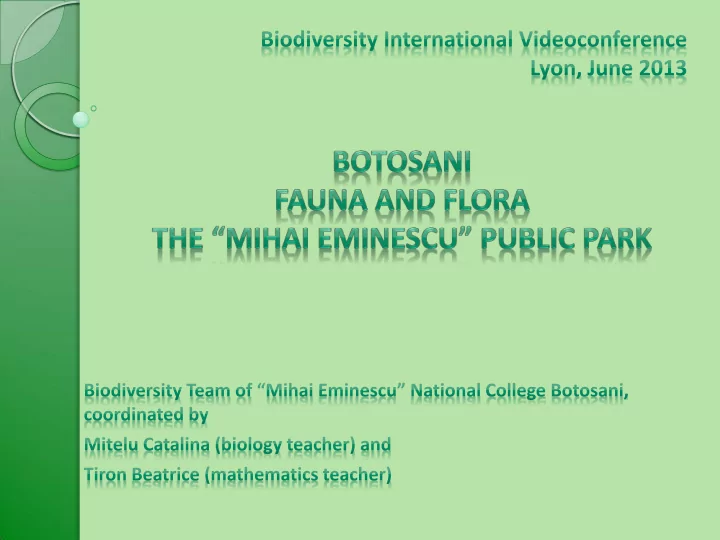

ANA MARINA DIANA CĂTĂLINA SABINA CLAUDIA
The ecosystem of our park
Mosses
Plants
The roses of Damasc The flowers are renowned for their fine fragrance, and are commercially harvested for rose oil (either "rose otto" or "rose absolute") used in perfumery and to make rose water and "rose concrete". The flower petals are also edible. They may be used to flavor food, as a garnish, as a tisane, and preserved in sugar as gulkand.
Clover Clover (Trifolium), or trefoil, is a genus of about 300 species of plants in the leguminous pea family Fabaceae. The genus has a cosmopolitan distribution; the highest diversity is found in the temperate Northern Hemisphere, but many species also occur in South America and Africa, including at high altitudes on mountains in the tropics .
Insects
Misumena vatia Misumena vatia is a species of crab spider. It is called the goldenrod crab spider or flower (crab) spider,because it is commonly found hunting in goldenrod sprays in the autumn. These spiders may be yellow or white, depending on the flower in which they are hunting. Especially younger females, which may hunt on a variety of flowers such as daisies and sunflowers, may change color "at will".
Pyrrhocoris apterus
Rose bug - Cetonia Aurata Known as the rose chefer , or more rarely as the green rose chefer , is a betlle , 20 mm long ,that has metalic green colouration (but can be bronze , copper , violet , blue/black or grey ) with a distinct shape . Scutellum ,the small triangular area between the wing cases just below the thorax , and having several other irregular small white lines and marks . The underside is a coppery colour .
Water mosquito Order Diptera,family of Culicidae Athough a few species are harmless or even useful to humanity, most are a nuisance because they consume blood from living vertebrates, including humans. The females of many species of mosquitoes are blood-eating pests. In feeding on blood, some of them transmit extremely harmful human and livestock diseases, such as malaria, yellow fever and filariasis. Some authorities argue accordingly that mosquitoes are the most dangerous animals on Earth.
Tadpoles are young amphibians that usually live in the water, though some tadpoles may be terrestrial. During the tadpole stage of the amphibian life cycle, most respire by means of autonomous external or internal gills. They do not usually have arms or legs until the transition to adulthood, and typically have dorsal or fin-like appendages and a tail with which they swim by lateral undulation, similar to most fish.
Frogs Frogs are a diverse and largely carnivorous group of short-bodied, tailless amphibians composing the order Anura (Ancient Greek an-, without + oura, tail). The oldest fossil "proto-frog" appeared in the early Triassic of Madagascar, but molecular clock dating suggests their origins may extend further back to the Permian, 265 million years ago. Frogs are widely distributed, ranging from the tropics to subarctic regions, but the greatest concentration of species diversity is found in tropical rainforests.
Birds
The House Sparrow The House Sparrow (Passer domesticus) is a bird of the sparrow family Passeridae, found in most parts of the world. A small bird, it has a typical length of 16 cm (6.3 in) and a weight of 24 – 39.5 g (0.85 – 1.39 oz). Females and young birds are coloured pale brown and grey, and males have brighter black, white, and brown markings. One of about 25 species in the genus Passer, the House Sparrow is native to most of Europe, the Mediterranean region, and much of Asia.
Turdus merula The Common Blackbird (Turdus merula) is a species of true thrush. It is also called Eurasian Blackbird (especially in North America, to distinguish it from the unrelated New World blackbirds), or simply Blackbird, where this does not lead to confusion with a similar-looking local species. It breeds in Europe, Asia, and North Africa, and has been introduced to Australia and New Zealand.
The Great Tit The Great Tit (Parus major) is a passerine bird in the tit family Paridae. It is a widespread and common species throughout Europe, the Middle East, Central and Northern Asia, and parts of North Africa in any sort of woodland. It is generally resident, and most Great Tits do not migrate except in extremely harsh winters. Until 2005 this species was lumped with numerous other subspecies.
Mammals
Street dog Street dogs, known in scientific literature as free-ranging urban dogs or urban free-ranging dogs, are unconfined dogs that live in cities. They live virtually wherever cities exist and the local human population allows. Street dogs may be pets which have strayed from or are simply allowed freedom by their owners, or may never have had an owner. Street dogs may be stray purebreds, true mixed-breed dogs, or unbred landraces such as the Indian pariah dog
Recommend
More recommend